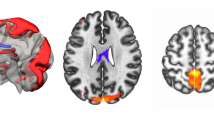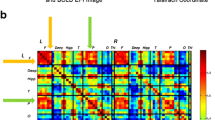Abstract
Resting state functional magnetic resonance imaging (RS-fMRI) is a popular method of visualizing functional networks in the brain. One of these networks, the default mode network (DMN), has exhibited altered connectivity in a variety of pathological states, including brain tumors. However, very few studies have attempted to link the effect of tumor localization, type and size on DMN connectivity. We collected RS-fMRI data in 73 patients with various brain tumors and attempted to characterize the different effects these tumors had on DMN connectivity based on their location, type and size. This was done by comparing the tumor patients with healthy controls using independent component analysis (ICA) and seed based analysis. We also used a multi-seed approach described in the paper to account for anatomy distortion in the tumor patients. We found that tumors in the left hemisphere had the largest effect on DMN connectivity regardless of their size and type, while this effect was not observed for right hemispheric tumors. Tumors in the cerebellum also had statistically significant effects on DMN connectivity. These results suggest that DMN connectivity in the left side of the brain may be more fragile to insults by lesions.


Similar content being viewed by others
Explore related subjects
Discover the latest articles and news from researchers in related subjects, suggested using machine learning.References
Mevel K, Grassiot B, Chetelat G, Defer G, Desgranges B, Eustache F (2010) The default mode network: cognitive role and pathological disturbances. Rev Neurol 166:859–872. doi:10.1016/j.neurol.2010.01.008
Raichle ME, MacLeod AM, Snyder AZ, Powers WJ, Gusnard DA, Shulman GL (2001) A default mode of brain function. Proc Natl Acad Sci USA 98:676–682. doi:10.1073/pnas.98.2.676
Broyd SJ, Demanuele C, Debener S, Helps SK, James CJ, Sonuga-Barke EJ (2009) Default-mode brain dysfunction in mental disorders: a systematic review. Neurosci Biobehav Rev 33:279–296. doi:10.1016/j.neubiorev.2008.09.002
Maesawa S, Bagarinao E, Fujii M, Futamura M, Motomura K, Watanabe H, Mori D, Sobue G, Wakabayashi T (2015) Evaluation of resting state networks in patients with gliomas: connectivity changes in the unaffected side and its relation to cognitive function. PLoS ONE 10:e0118072. doi:10.1371/journal.pone.0118072
Harris RJ, Bookheimer SY, Cloughesy TF, Kim HJ, Pope WB, Lai A, Nghiemphu PL, Liau LM, Ellingson BM (2014) Altered functional connectivity of the default mode network in diffuse gliomas measured with pseudo-resting state fMRI. J Neurooncol 116:373–379. doi:10.1007/s11060-013-1304-2
Liu J, Qin W, Wang H, Zhang J, Xue R, Zhang X, Yu C (2014) Altered spontaneous activity in the default-mode network and cognitive decline in chronic subcortical stroke. J Neurol Sci 347:193–198. doi:10.1016/j.jns.2014.08.049
Dacosta-Aguayo R, Grana M, Iturria-Medina Y, Fernandez-Andujar M, Lopez-Cancio E, Caceres C, Bargallo N, Barrios M, Clemente I, Toran P, Fores R, Davalos A, Auer T, Mataro M (2015) Impairment of functional integration of the default mode network correlates with cognitive outcome at three months after stroke. Hum Brain Mapp 36:577–590. doi:10.1002/hbm.22648
Rorden C, Brett M (2000) Stereotaxic display of brain lesions. Behavioural neurology 12:191–200
Hafkemeijer A, van der Grond J, Rombouts SA (2012) Imaging the default mode network in aging and dementia. Biochim Biophys Acta 1822:431–441. doi:10.1016/j.bbadis.2011.07.008
Cox RW (1996) AFNI: software for analysis and visualization of functional magnetic resonance neuroimages. Comput Biomed Res Int J 29:162–173
Cox RW, Hyde JS (1997) Software tools for analysis and visualization of fMRI data. NMR Biomed 10:171–178
Murphy K, Birn RM, Bandettini PA (2013) Resting-state fMRI confounds and cleanup. NeuroImage 80:349–359. doi:10.1016/j.neuroimage.2013.04.001
Smith SM, Jenkinson M, Woolrich MW, Beckmann CF, Behrens TE, Johansen-Berg H, Bannister PR, De Luca M, Drobnjak I, Flitney DE, Niazy RK, Saunders J, Vickers J, Zhang Y, De Stefano N, Brady JM, Matthews PM (2004) Advances in functional and structural MR image analysis and implementation as FSL. NeuroImage 23(Suppl 1):S208–S219. doi:10.1016/j.neuroimage.2004.07.051
Dipasquale O, Griffanti L, Clerici M, Nemni R, Baselli G, Baglio F (2015) High-dimensional ICA analysis detects within-network functional connectivity damage of default-mode and sensory-motor networks in Alzheimer’s disease. Front Hum Neurosci 9:43. doi:10.3389/fnhum.2015.00043
Shirer WR, Ryali S, Rykhlevskaia E, Menon V, Greicius MD (2012) Decoding subject-driven cognitive states with whole-brain connectivity patterns. Cereb Cortex 22:158–165. doi:10.1093/cercor/bhr099
Filippini N, MacIntosh BJ, Hough MG, Goodwin GM, Frisoni GB, Smith SM, Matthews PM, Beckmann CF, Mackay CE (2009) Distinct patterns of brain activity in young carriers of the APOE-epsilon4 allele. Proc Natl Acad Sci USA 106:7209–7214. doi:10.1073/pnas.0811879106
Smith SM (2012) The future of FMRI connectivity. NeuroImage 62:1257–1266. doi:10.1016/j.neuroimage.2012.01.022
Winkler AM, Ridgway GR, Webster MA, Smith SM, Nichols TE (2014) Permutation inference for the general linear model. NeuroImage 92:381–397. doi:10.1016/j.neuroimage.2014.01.060
Nichols TE, Holmes AP (2002) Nonparametric permutation tests for functional neuroimaging: a primer with examples. Hum Brain Mapp 15:1–25
Esposito R, Mattei PA, Briganti C, Romani GL, Tartaro A, Caulo M (2012) Modifications of default-mode network connectivity in patients with cerebral glioma. PLoS ONE 7:e40231. doi:10.1371/journal.pone.0040231
Ribolsi M, Daskalakis ZJ, Siracusano A, Koch G (2014) Abnormal asymmetry of brain connectivity in schizophrenia. Front Hum Neurosci 8:1010. doi:10.3389/fnhum.2014.01010
Jalili M (2014) Hemispheric asymmetry of electroencephalography-based functional brain networks. NeuroReport 25:1266–1271. doi:10.1097/WNR.0000000000000256
Thatcher RW, Biver CJ, North D (2007) Spatial-temporal current source correlations and cortical connectivity. Clin EEG Neurosci 38:35–48
Tucker DM, Roth DL, Bair TB (1986) Functional connections among cortical regions: topography of EEG coherence. Electroencephalogr Clin Neurophysiol 63:242–250
Medvedev AV (2014) Does the resting state connectivity have hemispheric asymmetry? A near-infrared spectroscopy study. NeuroImage 85(Pt 1):400–407. doi:10.1016/j.neuroimage.2013.05.092
Yan H, Zuo XN, Wang D, Wang J, Zhu C, Milham MP, Zhang D, Zang Y (2009) Hemispheric asymmetry in cognitive division of anterior cingulate cortex: a resting-state functional connectivity study. NeuroImage 47:1579–1589. doi:10.1016/j.neuroimage.2009.05.080
Middleton FA, Strick PL (2001) Cerebellar projections to the prefrontal cortex of the primate. J Neurosci 21:700–712
Middleton FA, Strick PL (1994) Anatomical evidence for cerebellar and basal ganglia involvement in higher cognitive function. Science 266:458–461
Habas C, Kamdar N, Nguyen D, Prater K, Beckmann CF, Menon V, Greicius MD (2009) Distinct cerebellar contributions to intrinsic connectivity networks. J Neurosci 29:8586–8594. doi:10.1523/JNEUROSCI.1868-09.2009
Krienen FM, Buckner RL (2009) Segregated fronto-cerebellar circuits revealed by intrinsic functional connectivity. Cereb Cortex 19:2485–2497. doi:10.1093/cercor/bhp135
Acknowledgments
The authors are grateful for the help given by Russell Butler in the writing of this paper.
Funding
K.W. is supported by a Canada Research Chair in Neurovascular Coupling and the Natural Sciences and Engineering Council of Canada (NSERC). S.G. is supported by a research grant from the Faculty of Medicine and Health Sciences of Université de Sherbrooke.
Author information
Authors and Affiliations
Corresponding author
Rights and permissions
About this article
Cite this article
Ghumman, S., Fortin, D., Noel-Lamy, M. et al. Exploratory study of the effect of brain tumors on the default mode network. J Neurooncol 128, 437–444 (2016). https://doi.org/10.1007/s11060-016-2129-6
Received:
Accepted:
Published:
Issue Date:
DOI: https://doi.org/10.1007/s11060-016-2129-6




